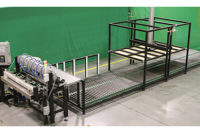Fourteen tubes of polyurethane sealant and an older suburban Western Pennsylvania home made for a perfect fit to seal in noteworthy energy savings. More than a do-it-yourself weekend project, this endeavor was part of a polyurethane sealant lifecycle assessment (LCA) to demonstrate the benefits of polyurethane sealants. An LCA is a holistic evaluation of the environmental impacts from all stages of a product’s life, from raw material acquisition to end-of-life, according to ISO 14040/44.
It is well known that the envelope of a home or other type of building needs to be sealed to minimize heat or cooling loss. Indeed, a typical home loses as much as 20% of heat through ventilation and drafts, according to the UK-based National Insulation Association.
Bridging the gaps in a home or building can bring significant heating and cooling savings, and ultimately reduce energy usage. The benefits can extend well beyond the individual home or building. This recently completed LCA shows the numbers behind the benefits of a well-sealed home.
Location and Home Condition
A two-story, brick façade Colonial home built circa 1955 near Pittsburgh was chosen for the LCA. The product evaluated was a moisture-cure polyurethane sealant applied to the 2,000-sq-ft home. The home, built by George Studen and local craftsmen, features vintage windows that are single pane with storm windows, a vintage natural gas furnace, and electricity supplied via nearby coal/nuclear power plants.
Prior to the project, failed sealant was visible around windows and doors, as well as most headers on the first and second floors. While re-sealing attempts had been made, failed acrylic and silicon sealants were observed. In addition, there were several unsealed penetrations into the home’s envelope for cables, pipes and venting. On a positive note, some of the basement window headers were well sealed.
To prepare the site, the existing sealant was removed. The best method for sealant removal was the use of an oscillating scraper, followed by a wire brush. The substrate was then prepped with a solvent wipe.
Initial Testing and Sealant Application
Researchers had a blower door test conducted before applying the new sealant. Settings were based on the test standard specified by the Canadian General Standards Board in depressurization mode. During the initial testing, air gaps were discovered in the living room door, around the base of a stairway window, the top joint of the door to the garage, the top of a basement window and the southwest and northwest basement corners. The gaps were found by observing air that deflected plastic strips and by comparing infrared thermal images with the blower door on vs. with it off. Gaps with active leaks registered a lower temperature on the infrared pictures.
The next step was the purchase of approximately 14 tubes of moisture-curing polyurethane sealant. The manufacturer’s data sheet for the sealant indicated that the sealant is ASTM C-920 class 25 rated, and compliant with the California Air Resources Board (CARB), the South Coast Air Quality Management District for Orange County, Calif., and the Ozone Transport Commission.
The sealant was applied to seal gaps, such as those around doors, windows, holes for pipes and cables, and those discovered in the southwest and northwest basement corners, in the home’s envelope.
Results
Researchers conducted a second blower door test after the sealant application. Given the minimal investment—less than $75 to purchase the polyurethane sealant—the study’s results were impressive.
• A comparison of the blower door testing performed before and after the sealant application showed a 25% reduction in airflow. More specifically, the steady-state air flow before was 2,817 cu ft/min (CFM) at
50 Pascals (Pa); afterward it was 2,118 CFM at 50 Pa.
• The sealant application contributed to an estimated 10-year energy savings equivalent to a 60-watt bulb operating for 12.7 years continuously, based on a 70% efficiency furnace and an air conditioner seasonal energy-efficiency ratio (SEER) of 10. (See Figure 1.)
• Estimated greenhouse gas emissions avoidance during a 10-year period is equivalent to 32 acres of U.S. forest. (See Figure 2.)
• There is approximately 10 times the amount of energy savings per year compared with the amount of energy embodied in the sealant. (See Figure 3.)
• A short payback period—as little as four months in one estimate—quickly offsets the initial investment in a polyurethane sealant. (See Figure 4.)
Far-Reaching Benefits
Using a polyurethane sealant to bridge the gaps in a home or other type of building can bring significant heating and cooling savings through reduced energy usage. In this case, application of a polyurethane sealant in a 1955 Colonial home in the Pittsburgh area reduced airflow by 25% based on before and after blower door testing. As this LCA demonstrates, the seemingly simple act of sealing a home’s drafts can lead to benefits that extend well beyond that individual home or building.
For additional information, visit www.bmsnafta.com.







